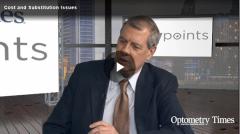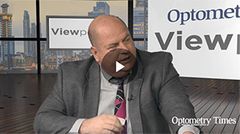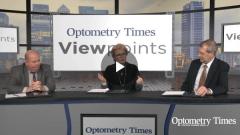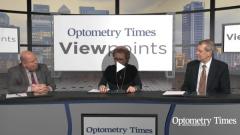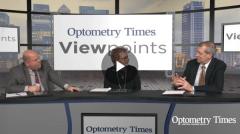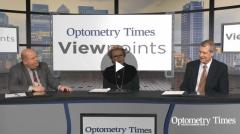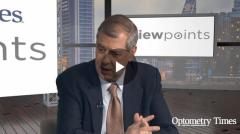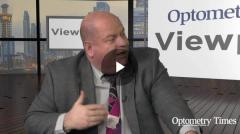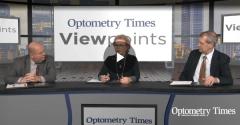
Initiating Anti-Inflammatory/Immunomodulatory Therapy
Episodes in this series

Eye care experts offer their perspectives on initiating anti-inflammatory/immunomodulatory treatment for dry eye disease.
[Transcript]
Marguerite McDonald, MD, FACS: When do you decide it’s now time for a prescription medication for dry eye? What are your [considerations]?
Richard Mangan, OD, FAAO: I’ll tell you what I look at. If there is any kind of surface staining whatsoever, I feel that artificial tears are not going to get the job done. At that point, [I prescribe medication]. Then I look at risk factors. I’ve had some patients who have been diagnosed with Sjögren syndrome, yet they haven’t really shown the ocular surface issues yet, but I’m proactive with it there as well. How about you, Eric?
Eric Donnenfeld, MD, FACS: For me it’s an informed consent decision when I talk to patients with dry eye. When I talk to patients, I say, “We can treat you palliatively—I can give you a drop that will make you feel better—or I can treat the disease. Would you rather have something that makes you feel better or something that actually treats the disease process?” I’ve come to learn that when patients come to see an eye doctor, they’re not there because they want to be there. They’re there because they have a problem. These patients [who come because of dry eye] usually have at least level 2 dry eye. Otherwise they wouldn’t bother to be coming in.
So, I’m very proactive about using immunosuppressive therapy. It’s effective. It’s [used] twice a day. Whatever artificial tear you use cannot in any way come close to matching the quality of tears that the human produces. There are over 200 proteins in a human tear. You don’t get that with an artificial tear.
I like to manage patients with dry eye aggressively. I believe in immunosuppressive therapy. I think it’s the core of managing these patients, and I have no problem with starting level 1 patients on [an] immunosuppressive [agent]. We have 2 that are available right now. We have lifitegrast. We have cyclosporine. Both work very effectively. There’s no head-to-head studies that show one is better than the other. They both work very well. But we do know that lifitegrast works more rapidly. We like that aspect of it, that it’s a more rapid onset of action, and I think that is really important to patients that they get relief sooner rather than later.
Richard Mangan, OD, FAAO: I think what you brought up was key. They did a poll years ago and they found that by the time patients actually come in to your office, they’ve already tried 3.5 different types of over-the-counter products, artificial tears. If all we do is hand them an artificial tear sample from the cabinet, they’re just going to think, this is what it’s all about, this is what dry eye is, you just have to live with it. Yes, keep in mind if patients are coming to your office, it’s really bothering them.
Eric Donnenfeld, MD, FACS: It’s interesting in that, Marguerite and I are both very busy surgeons, we do a lot of surgery. But to me, the greatest opportunity that I have to impress a patient is managing those with dry eye because many have had a problem for years, if not decades. They haven’t gotten relief. No one they’ve spoken to has really gotten to the base of what’s happening and why there is a problem. They pass the buck. They give them 3 different tears, and they say pick the 1 you like best.
When you can take a patient who’s had 3 or 4 different eye care professionals managing them but have not gotten relief and you can make them better, those become very important referrers to your practice. I think dry eye is a very important way of growing a practice.
Marguerite McDonald, MD, FACS: You mentioned, Rich, central or any kind of corneal staining is a trigger for a prescription medication. I agree with you. Also, conjunctival staining in the classic pattern.
Eric Donnenfeld, MD, FACS: What stains do you use for conjunctival staining?
Marguerite McDonald, MD, FACS: Lissamine green. Between fluorescein and lissamine green, you learn so much, with the classic complaints to catch the borderline dry eye that’s going to decompensate right after your cataract or LASIK [laser-assisted in situ keratomileusis] surgery.
I also like the tear osmolarity test. I like objective tests because you can say to someone, “You have dry eye.” “No, I don’t. No, I don’t, I have no symptoms.” “Well, your tear osmolarity is supposed to be between 290 and 295 [mOsm/L] and it’s 350.” “Oh.” The numbers impress them. The InflammaDry test is very impressive as well for showing the MMP-9 [matrix metalloproteinase 9] increase that you see in dry eye patients.
Richard Mangan, OD, FAAO: I was asked a while ago if I were on a desert island, what 1 test would I do for my patients. It would have to be either LipiView or slit lamp photography because we’ve all had those cases where there is florid ocular surface staining, yet because the nerve function is so deteriorated, the patients are not really feeling all that bad. And to try to get someone to buy in to a branded medicine or therapy, it can be really challenging. But when you can show them the photograph of the ocular surface of their eye or show how their meibomian glands have atrophied, all of a sudden you’ve got their attention. Compliance goes way up.
Marguerite McDonald, MD, FACS: Documentation, numbers, and images—showing them, “This is what your glands are supposed to look like with meibography, and this is what yours look like.” It’s like a brick in the face.
Richard Mangan, OD, FAAO: It’s amazing how powerful it is.
Marguerite McDonald, MD, FACS: It enhances compliance tremendously.
Newsletter
Want more insights like this? Subscribe to Optometry Times and get clinical pearls and practice tips delivered straight to your inbox.


